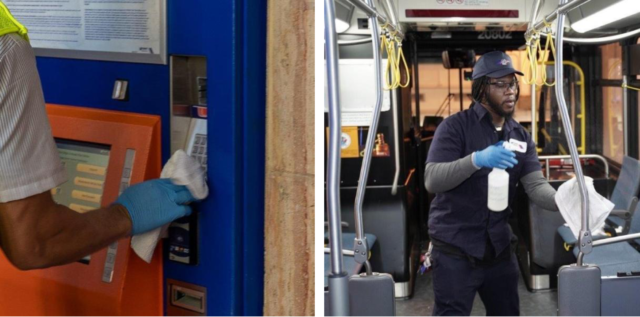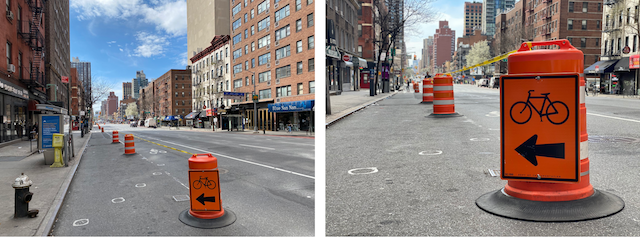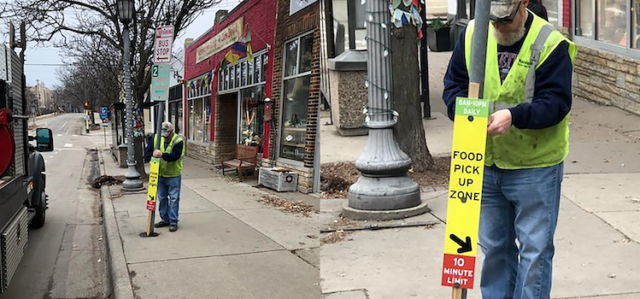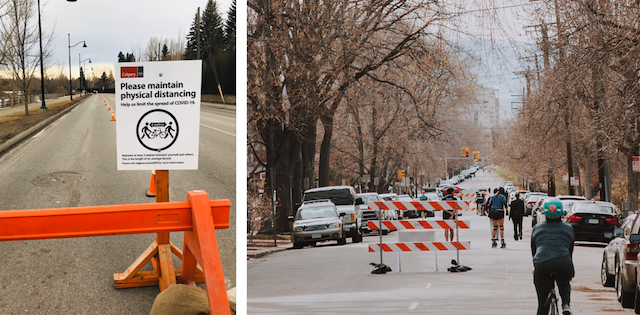
As of August 31, 2020, NACTO is no longer updating this toolkit. The actions recorded on this page reflect cities’ efforts to respond to the coronavirus pandemic between March and August 2020. For emerging city and transit agency response strategies, please see NACTO’s Streets for Pandemic Response and Recovery resource or visit nacto.org/covid19.

Actions:
1. Maintain transportation systems to safely move essential workers and goods
San Francisco Bay Area: BART staff are using hospital-grade disinfectant on high-touch surfaces in stations. On trains, handrails and stanchions are wiped at line terminals and a pre-existing “thorough clean” disinfecting process is performed daily. (2/25/2020)

NJ TRANSIT employees clean high-touch surfaces in stations on vehicles. (NJ TRANSIT)
Seattle, King County Metro: King County Metro is installing dividers on buses to physically separate the front area, where the bus operator works, from the general passenger area. Combined with rear-door boarding for most passengers, excluding seniors or people using mobility devices, these policies protect bus operators by encouraging more space between them and riders. (3/26/2020)
Detroit: The Detroit Department of Transportation instituted a rear-door boarding policy and waived fees for the duration of the coronavirus outbreak. To further minimize contact between frontline transit workers and riders, the seat behind the bus operator must remain empty. (3/24/2020)
San Antonio, VIA: VIA suspended fares systemwide to minimize interactions and help protect passengers and operators. With a fare-free policy, VIA also allowed all-door boarding to speed the boarding process and reduce crowding by the front door. (3/20/2020)
New York City, MTA: The MTA initiated a rear-door boarding policy for all local and Select Bus Service Routes, requiring passengers to board and exit through the rear door to protect bus operator safety. Regular fare policy remains in effect. (3/20/2020)

King County Metro is installing “safety straps” on its buses to separate riders and drivers and reinforce social distancing. (King County Metro)
San Francisco: In response to changing trip needs and operator availability, Muni temporarily reduced service in order to prioritize critical routes for essential workers and trips while maintaining service levels needed for social distancing. (4/6/2020)
San Francisco: Jeff Tumlin, Director of SFMTA, shares how the pandemic has impacted transportation in San Francisco and how the agency is both affected by and responding to it. (4/7/2020)
See Rapid Response Tools for Transit Agencies for more response strategies.
Lima: To offset capacity restrictions on buses, Lima plans to encourage people to bike by installing 301 km (187 miles) of temporary emergency bicycle lanes. They will tie into the existing bike network and double the amount of bike facilities in the city. (4/25/2020)
Milan: In anticipation of eased lockdowns, Milan is launching an ambitious plan to limit car use by rapidly building 35 km (22 miles) of expanded bike and pedestrian spaces citywide. Read Milan’s Open Streets adaptation strategy guide, which details strategies, actions, and tools to improve walking and biking. (4/21/2020)
New York City: The NYC Department of Transportation installed temporary protected bike lanes along two busy bike corridors that currently lack protected infrastructure. These helped “plug two key gaps” in the city’s bike network and tied into existing protected bike facilities. (3/20/2020)

Temporary bike facilities installed along 2nd Avenue in Manhattan in response to the emergence of COVID-19. (@foeniculum on Twitter)
Harris County, Texas: In the stay-home-work-safe order issued for Harris County, bicycle repair is defined as an essential retail business, permitting the people living in the county, including Houston, to access bike repair for the duration of the order. (3/24/2020)
San Francisco: When San Francisco issued a Public Health Order requiring people to stay at home except for essential needs, the City included bicycle repair shops as essential businesses. Mayor London Breed also confirmed this on Twitter. (3/16/2020)
Chicago: Chicago and the City’s bike share partner, Divvy, are offering discounts on a range of Divvy memberships, including half-off annual memberships and over sixty percent off single rides. They also launched a program to give healthcare workers free rides through April 30. (3/24/2020)
New York City: New York City and its bike share partner Citi Bike, are offering 30 days of free bike share access to healthcare workers and expanding cleaning and valet services near hospitals. (3/24/2020)
London: National Health Service workers will be given a code that waives the 24-hour access fee for London’s bike share system, Santander Cycles. This gives frontline employees free travel under 30 minutes; balancing stations near hospitals will be prioritized to ensure regular access to bikes. (3/20/2020)
Providence, RI.: Providence automated all city-owned pedestrian signals across the city, eliminating a high-touch point for people crossing the street. (4/6/2020)
Brookline & Cambridge, MA: Both municipalities are adjusting pedestrian signals so pushing a button is no longer needed to cross the street. This limits the amount of surfaces a person must touch, helping curb the spread of COVID-19. (3/26/2020)

New signage in Calgary clearly communicates “Do Not Push the Button” because pedestrian signals are now automatic. (@AngelaKnightCBC)
Austin: After stay home orders reduced motor vehicle traffic on its streets, Austin retimed signals on multiple major corridors to limit travel delay for all road users, including people walking, biking, and scooting, by reducing time between signal phases. (4/20/2020)
Los Angeles: In response to lower vehicle volumes and higher observed vehicle speeds, Los Angeles adjusted signals throughout the city to “nighttime mode” to encourage safer driving. This adjustment changes signals to red when traffic volumes are low, reducing the speed opportunity caused by green waves of signals. (4/15/2020)
New York City: New York City installed 15 MPH signal progressions on three corridors, which will help reduce the amount of red lights people on bikes face as they travel. This is part of New York City’s Green Wave plan to improve biking safety citywide, released in 2019. (3/20/2020)
2. Keep front-line workers safe, and actively manage and support both operational and remote office workforces
Boston: Boston is providing face masks for all essential city employees that must work outside their homes. (4/5/2020)
Madison, WI: For essential city services that require in-field operations, Madison instituted new safety protocols that allow staff to work independently in the field to maintain social distancing. (4/1/2020)
Frankston, Australia: To allow staggered staff start times, waste collection in Frankston is now starting 30 minutes earlier than usual. This will promote social distancing for operational workers. (3/25/2020)
Minneapolis: Robin Hutcheson, Director of Public Works for Minneapolis and NACTO Board President, discusses how the department has rapidly shifted priorities, defined essential work, and kept employees safe in the first weeks of Minnesota’s Stay at Home order. (4/21/20)
Minneapolis: The Minneapolis Department of Public Works developed guidance for field work best practices during the coronavirus pandemic, including social distancing protocols in department vehicles and maintaining a sanitary mask. (4/15/2020)
The Management Center: In response to COVID-19, the Management Center adjusted their internal policies. This document is available online and provides policy and communications recommendations for internal management at other organizations. (3/9/2020)
Seattle, King County Metro: King County has an existing telework/telecommuting policy to support employee flexibility and productivity. This program includes clear instructions for employees and managers seeking to implement telework. This existing policy helped support a coordinated transition for office staff. (4/12/2018)
3. Address immediate delivery & pick-up needs
Seattle: Grocery stores in Seattle are enforcing safe social distancing habits by marking where patrons should stand when waiting in line to enter the store or check out. Safe distances are indicated on the floor or sidewalk using a removable material. (3/22/2020)
Austin: The Austin Transportation Department installed temporary customer pick-up zones by converting some paid on-street parking spaces near restaurants. This will support access to restaurants that now offer take-out and delivery-only service while also promoting social distancing. (3/19/2020)
Memphis: Memphis initiated on-street parking relief at restaurant locations in two neighborhoods with parking meters. On-street parking is allowed at no charge in front of restaurants in these locations until further notice. (3/17/2020)
Seattle: Seattle installed free temporary loading zones to support restaurants providing food pick-up service. These passenger loading zones are free for 3 minutes, marked with temporary signage, and are located along streets with restaurants citywide. (3/17/2020)

A City of Minneapolis employee installs signage designating a temporary food pick-up zone. (City of Minneapolis)
4. Relieve crowded areas (i.e. parks and narrow sidewalks) to support health department guidance for physical distancing
Denver: Denver temporarily closed select roads to thru-traffic to create more space for residents to go outside and get fresh air while practicing safe social distancing. The city is prioritizing street closures in areas with high population densities and where adjacent parks are seeing significant use. On-street parking and local, essential, and emergency vehicles are still allowed. (4/3/2020)
Calgary: Calgary piloted the closure of six roadway sections in order to create more open space for people to safety go outside and still avoid contact with others. The initial closures are in higher density areas of the city. (3/27/2020)
Burlington, VT: Nicole Losch, a senior planner from Burlington, VT, shares how the city creatively allocated limited materials and worked with the local community to designate temporary shared streets and alleviate pressure on sidewalks and parks. (4/22/20)
Oakland: Ryan Russo, Director of the Oakland Department of Transportation, shares how the city launched Slow Streets, adapting neighborhood streets across the city for social distancing. (4/27/2020)

Temporary street closures in Calgary and Denver (L to R) to create more space for outdoor social distancing. (@AngelaKnightCBC, @jlocantore)
Consider using existing Open Streets/Ciclovia plans
Winnipeg: Winnipeg designated four streets as as bicycle/active transportation routes, limiting motor motor vehicle traffic in each to one block. Under normal circumstances, these routes are in place on Sundays, from June to September. Currently, they will be in place daily from 8 a.m. to 8 p.m. until May 3. (3/31/2020)
Philadelphia: To facilitate social distancing among trail users, Philadelphia closed Martin Luther King Jr., Drive to motor vehicle traffic until further notice. This street goes through a park and has no delivery needs; every April through October, it is closed to motor vehicle traffic for daytime hours on weekends. (3/20/2020)
Vancouver: To expand available spaces for outdoor social distancing, Vancouver closed roadways within Stanley Park to vehicles and also repurposed motor vehicle lanes on nearby Beach Ave into a lane for people walking and biking. These spaces are not designated for congregation, public communications encourage people to keep moving when using them. (4/7/2020)
Minneapolis: Minneapolis closed sections of riverfront parkways to motor vehicle traffic to allow more space for trail users to practice safe social distancing. Closures remain in effect for the duration of the statewide Emergency Executive Order; Minneapolis is also working to identify additional parkway closures. (3/26/2020)
Toronto: Toronto program is expanding pedestrian waiting spaces in select areas outside essential businesses to encourage physical distancing in areas where it is challenging for people to keep safe distances. (4/27/2020)
Montreal: Montreal is establishing “public health corridors” along densely-populated commercial streets. Bollards will be placed 2.5m from the sidewalk, expanding space for pedestrians to safely pass each other when outside. (4/16/2020)
Brookline, MA: Brookline, Massachusetts is reconfiguring vehicle and parking lanes along highly-used streets in order to create more space for people to access essential services. (4/9/2020)
Washington, DC: Washington, DC implemented traffic control measures around the Tidal Basin–a major attraction that drew crowds despite social distancing suggestions–to discourage visitors and facilitate safer public health conditions. (3/22/2020)
Pittsburgh: Pittsburgh closed access to the Mount Washington overlook, a popular sightseeing location in the city, to restrict the opportunity for unsafe social distancing practices. (3/30/2020)
5. Create clear messaging of city policies and guidelines
New York City, MTA: New York City Transit rebranded their Twitter page to communicate a vital public health directive: “Stay home. Stop the spread.” (3/25/2020)
Detroit: Detroit’s Chief Public Health Officer posted guidance for governments to produce clear messaging around public health recommendations. (3/23/2020)
San Francisco: Mayor London Breed used simple, direct language to communicate public health protocol when the city closed playgrounds to encourage more stringent social distancing. (3/23/2020)

London, Transport for London: Transport for London installed blue stickers every two meters apart in busy stations, clearly communicating safe social distances for people using the system for essential travel. (4/3/2020)
Houston, METRO: To alert riders to social distancing protocol, METRO installed placards on all buses asking people not to sit close to one another. (3/20/2020)

Transport for London installed blue floor markings spaced at two meters to mark where to stand for social distancing. (TfL)
6. Support unsheltered and vulnerable populations
Detroit: The City of Detroit, with support from local businesses and health systems, opened a testing site at state fairgrounds. Per Mayor Mike Duggan, individuals who need a ride to the site are asked to request this when setting up their appointment. (3/25/2020)
Montreal: The walk-in testing site in downtown Montreal is located in a plaza and accessible for both pedestrians and people arriving by car. Individuals are monitored to maintain social distancing protocol when in line and are asked not to take public transit to the site. (3/23/2020)
Detroit: Detroit is making transportation services available to city residents who do not have their own means of transportation to access COVID-19 testing. (4/2/2020)
Detroit: Mark de la Vergne, Chief of Mobility Innovation for the City of Detroit, and Nick Mosquera from Bloomberg Associates discuss how Detroit has established new modes of transport for citizens in need of urgent medical care in the midst of the coronavirus pandemic. (4/15/20)
Baltimore: Baltimore will provide transportation for residents who are staying in city shelters to get tested for COVID-19. (3/25/2020)
New York City: New York City is actively recruiting drivers licensed by the Taxi and Limousine Commission to deliver food to senior citizens and other populations who need to stay in their homes during the COVID-19 outbreak. (3/23/2020)